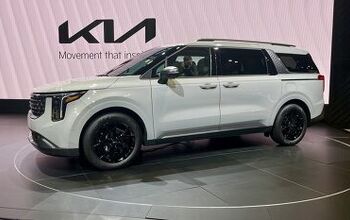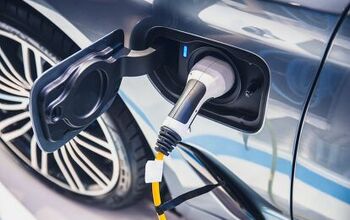Top 10 Things You Should Know About the McLaren P1

Few car companies are committed to all-out performance quite like McLaren. The boutique British brand is probably best known for its outrageous F1 supercar that set speed records in the 1990s. But the company is far from a one-hit wonder. Over the last decade and a half they’ve been active in racing, worked with other automakers like Mercedes-Benz to deliver some awe-inspiring vehicles and have even developed a successor to the F1 – the elegant looking but awkwardly named MP4-12C.
SEE ALSO: 2013 Geneva Motor Show Coverage
Pushing into the future, McLaren is set to reveal a new supercar at the Geneva Motor Show in just a few days, and believe it or not the P1 as it’s known is actually a hybrid. But don’t worry; it’ll still deliver absolutely crushing performance. Here are the Top 10 things you must know about this exciting new McLaren before it takes the stage next week.
Ever wonder what it’s like riding an explosion? The P1’s acceleration should approximate the detonation of a hydrogen bomb. According to McLaren representatives the car can rocket from a standstill to 100 kilometers an hour (62 miles an hour) in less than three seconds. It can top 200 km/h (124 MPH) in about seven seconds. And in less time than it takes to read this paragraph the car will blow past 300 km/h, roughly 186 miles an hour. The P1 is electronically limited to 350 km/h (218 MPH), probably to preserve the integrity of space-time and prevent blowing a hole through the Milky Way Galaxy.
A 3.8-liter gasoline-fed V8 engine is mounted amidships. That’s not a very big powerplant considering how absurdly fast the P1 is. Making up for its displacement deficit are two turbochargers, which force air down its gullet, greatly enhancing output. An electric motor augments the engine and helps deliver a system total of 903 brake horsepower, though the motor is primarily there to enhance throttle response and improve drivability. Torque is quoted at 900 Newton metres. In real numbers that’s about 664 lb-ft. McLaren calls this drivetrain IPAS, short for Instant Power Assist. A seven-speed dual-clutch transmission handles all the power and routes it to the rear wheels.
Yep, you read it right. Like a Toyota Prius the P1 is actually a hybrid. Its battery weighs just 96 kilograms, about 212 pounds, and can provide a pure-electric range of up to 20 kilometers in low-speed city driving. To keep the car’s center of gravity as low as possible it’s mounted to the underside of the chassis. To optimize performance and reliability the pack is liquid cooled.
Of course regenerative braking is part of the P1’s powertrain but that’s not the only way to juice the battery. The car is also equipped with a plug-in charger, which can take the pack from completely empty to 100 percent full in just two hours.
Power is useless without control. To keep its 903-pony corral safely in check engineers fitted the P1 with some impressive brakes. The car’s binders were developed by Akebono, the company’s Formula 1 partner. As such, the P1 is fitted with a brand-new kind of carbon-ceramic disc. Apparently they’ve been used in space but have never been fitted to a road-going car before. They’re said to be stronger than “regular” (if there is such a thing) carbon-ceramic brakes, more effective at dissipating heat and even lighter.
To deliver such terrifying performance figures the P1 has to be both light and strong, two attributes that under normal circumstances are mutually exclusive. But money can buy a lot of things, including an F1-grade carbon-fiber “MonoCage” chassis. This plastic tub should be super light yet tough as a steel girder – great for safety and performance.
The P1’s body was extensively tuned in a wind tunnel. The heart of its aerodynamics package is a special rear wing that automatically adjusts. During track driving it can extend rearward by up to 300 millimeters (almost a foot) and its pitch can be altered by 29 degrees. This variability enhances down force. Interestingly, just like a Grand Prix car the rear wing can be adjusted to reduce down force in certain situations, resulting in greater straight-line speed.
The car’s underbody was also tuned for performance. There are two automatically adjusting flaps mounded ahead of the front wheels that help tweak its aerodynamic efficiency for different driving conditions. At less than maximum speed the McLaren P1’s body generates 600 kilograms of down force (roughly 1,320 pounds), more than any production road car and about five times more than the MP4-12C.
The production version of the P1 looks remarkably similar to the concept that debuted at the Paris Motor Show last year, which is a good thing. Apparently over the last few months the company engaged potential customers and they overwhelmingly liked what they saw. The design is essentially unchanged, with one exception. Special ducts ahead of the front wheels were added to help with cooling and to optimize down force.
McLaren prides itself on building ultra-high performance machines that people can live with every day, and the P1 is no exception. Buyers are offered an array of color and trim options to choose from. Adding a little spice to the cabin, tons of carbon fiber is on display, running across the doors, A-pillars, dashboard and center tunnel. Options are very limited but one of the more interesting is fitted luggage. Nothing screams “ultra luxury” like custom bags designed to fit perfectly in a car’s trunk.
There’s no news to share on which global markets will be blessed with the McLaren P1, but it will be a rare and awesome sight to see one in the wild. The company only plans to build 375 examples of the car, making them exceedingly scarce, something that will almost certainly push their price tags even higher.
You’ve made it this far… ready for the bad news? A quote attributed to American financier and business tycoon J.P. Morgan sums up the McLaren P1’s MSRP quite succinctly: “If you have to ask the price, you can’t afford it.” The car starts at a wince-inducing £866,000; in ‘Murican money that’s more than $1.3 million. A steep price to pay for sure, but arguably worth it for one of the fastest road-going vehicles ever built.

Born and raised in metro Detroit, Craig was steeped in mechanics from childhood. He feels as much at home with a wrench or welding gun in his hand as he does behind the wheel or in front of a camera. Putting his Bachelor's Degree in Journalism to good use, he's always pumping out videos, reviews, and features for AutoGuide.com. When the workday is over, he can be found out driving his fully restored 1936 Ford V8 sedan. Craig has covered the automotive industry full time for more than 10 years and is a member of the Automotive Press Association (APA) and Midwest Automotive Media Association (MAMA).
More by Craig Cole










































Comments
Join the conversation
The Yugo also stayed much as the show car . . .
A car willabilitywell above what a normal or even a buy who can afford it skill level So mostly it goes wasted. Nice car yes, one of the best, worth it, up to you to decide and yes 375 people will decide it is worth it to them. Wanna race for pink slips ?